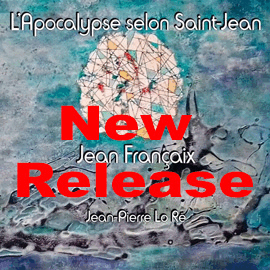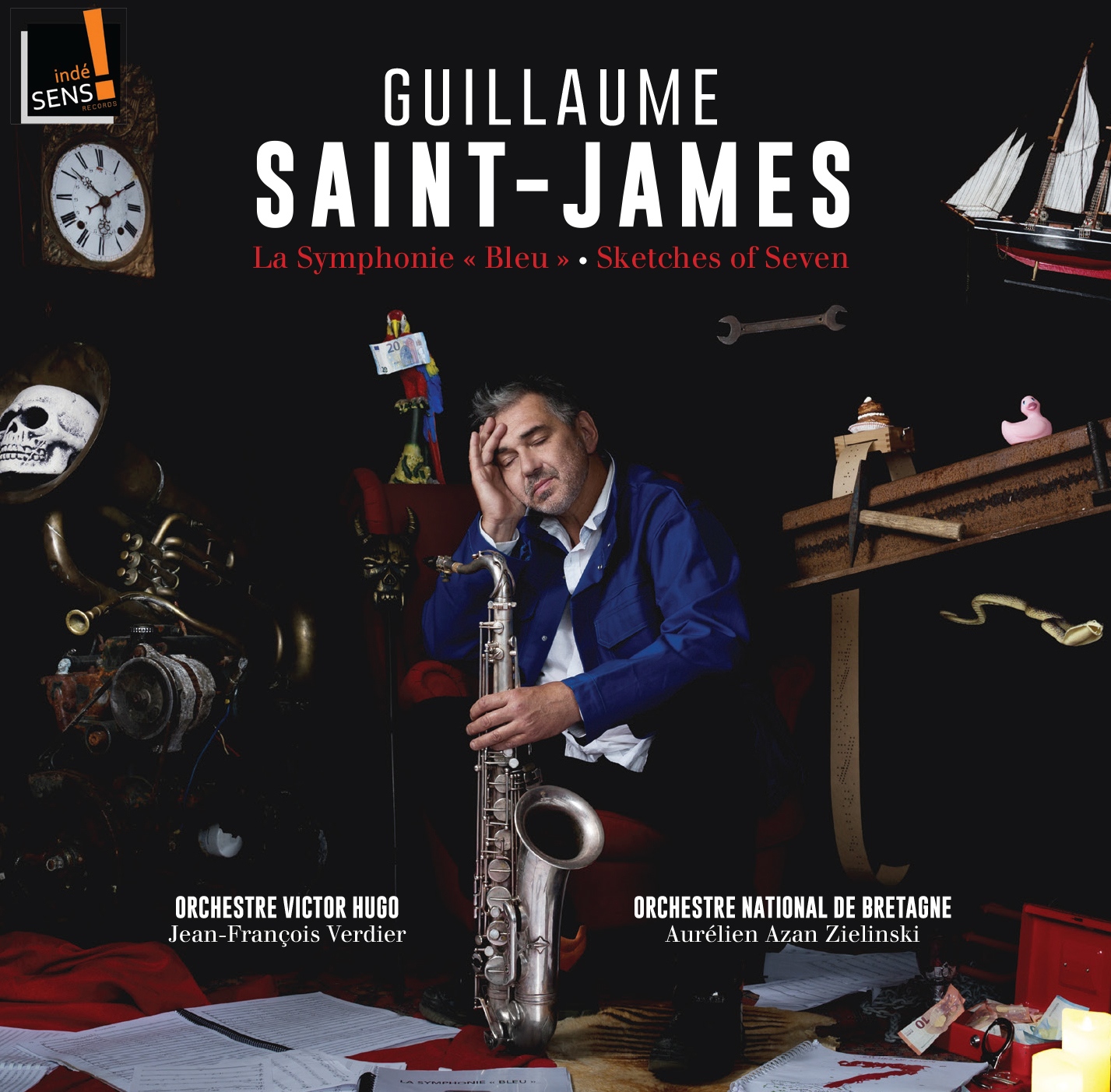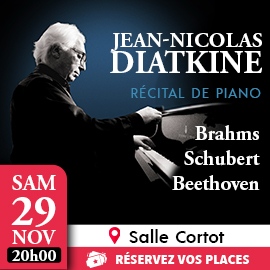Symphonischer Jazz
Die ‘Symphonie Bleu’ von Guillaume Saint-James ist eine Vermischung des Blues und der von Maschinen geprägten Arbeitswelt (mit ihrer blauen Arbeitskleidung). Sie gehört, genau wie Sketches of Seven, ein Konzert für Saxophon und Orchester, zur Gattung Symphonischer Jazz. Beide Kompositionen sind einfallsreich und raffiniert gemacht und werden vom Orchestre Victor Hugo (Bleu) und dem Orchestre National de Bretagne unter Jean-François Verdier und Aurélien Azan-Zielinski brillant dargeboten. Besonders zu erwähnen ist der Akkordeonist Didier Ithursarry, dem größte Virtuosität abgefordert wird. – Symphonie Bleu by Guillaume Saint-James is an amalgamation of the blues and the industry (with its blue collars and machines). It belongs, just like Sketches of Seven, a concerto for saxophone and orchestra, to the genre of symphonic jazz. Both compositions are imaginatively and cleverly done and brilliantly performed by the Orchestre Victor Hugo (Bleu) and the Orchestre National de Bretagne under Jean-François Verdier and Aurélien Azan-Zielinski. Special mention should be made of accordionist Didier Ithursarry, to whom the greatest virtuosity is demanded. (Indésens INDE147) – ♪♪♪♪
Nathalie Dessay in der Box
Erato würdigt die französische Sopranistin Nathalie Dessay mit einer Box, in der 33 CDs und 19 DVDs enthalten sind, mit Opernaufnahmen, die die Dessay in ihren größten Rollen zeigen (Zauberflöte, Contes d’Hoffmann, Orphée aux Enfers, Lakmé, Ariadne auf Naxos, Lucia de Lammermoor, Sonnambula, Le Rossignol, Hamlet, Pelléas et Mélisande, La Traviata, etc.). Natalie Dessays immer leichte und technisch tadellos Stimme mag fast mechanisch präzise sein, aber sie hat eine Rundheit, die das Timbre angenehm macht, eine Atemtechnik, die ihr bei ihren Interpretationen sehr hilft, ein wunderbares Legato, und eine makellose Artikulation. Der Reichtum der Farben und die dynamischen Nuancen, zu denen sie fähig ist, verblüffen ebenso. Und alles, was sie tut, ist natürlich, ohne Effekthascherei, mit einem sehr sicheren künstlerischen Stil, der im richtigen Maß zu Emotionen fähig ist. – Erato pays tribute to French soprano Nathalie Dessay with a box set containing 33 CDs and 19 DVDs, with opera recordings featuring Dessay in her greatest roles (Magic Flute, Contes d’Hoffmann, Orphée aux Enfers, Lakmé, Ariadne auf Naxos, Lucia de Lammermoor, Sonnambula, Le Rossignol, Hamlet, Pelléas et Mélisande, La Traviata, etc.). Natalie Dessay’s always light and technically impeccable voice may be almost mechanically precise, but she has a roundness that makes the timbre pleasing, a breathing technique that helps her greatly in her interpretations, a wonderful legato, and flawless articulation. The richness of color and the dynamic nuances she is capable of are equally astounding. And everything she does is natural, without showmanship, with a very secure artistic style, capable of emotion in the right measure. (Erato 0190295163136) – ♪♪♪♪
Rademann mit emotionaler Matthäuspassion
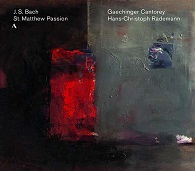 Nach seiner choreographierten DVD-Produktion bei Accentus (Pizzicato Rezension) kehrt Hans-Christoph Rademann mit der Gächinger Cantorey und einem teilweise erneuerten Solistenensemble zur Matthäuspassion zurück, ohne musikalisch viel Entwicklung zu zeigen. Der musikalische Ansatz bleibt immer noch weich und oft sehr emotional, aber das Musizieren ist auch alert und angenehm tänzerisch. Der Schwachpunkt liegt leider auch diesmal bei den Solisten. Kresimir Strazanac, der in der DVD-Fassung einen beeindruckenden Jesus sang, singt hier immer noch ganz gut die Bass-Arien, während Peter Harvey der Vox Christi einen sehr lyrischen, aber nicht besonders präsenten Charakter gibt. Das gilt auch für die Altistin Marie-Henriette Reinhold, bei der manche gehauchten Töne untergehen. Patrick Grahl gestaltet seinen Part als Evangelist charakteristisch und gefällt mir eigentlich sehr gut. Benedikt Kristjansson ist ein zuverlässiger Interpret der Tenor-Arien, aber die Stimme wird immer wieder durch die Instrumente überlagert. Die Sopranistin Isabel Schicketanz fügt sich gut in diese weiche und runde Matthäuspassion ein. – After his choreographed DVD production at Accentus (Pizzicato review) Hans-Christoph Rademann returns to the St. Matthew Passion with the Gächinger Cantorey and a partially renewed ensemble of soloists, without showing much development musically. The musical approach still remains soft and often very emotional, but the music-making is also alert and pleasantly dance-like. The weak point, unfortunately, is once again the soloists. Kresimir Strazanac, who sang an impressive Jesus in the DVD version, still sings the bass arias quite well here, while Peter Harvey gives the Vox Christi a very lyrical but not particularly present character. This also applies to the contralto Marie-Henriette Reinhold. Patrick Grahl shapes his part as the Evangelist characteristically and I actually like it very much. Benedikt Kristjansson is a reliable interpreter of the tenor arias, but the voice is repeatedly overshadowed by the instruments. Soprano Isabel Schicketanz fits well into this soft and round St. Matthew Passion. – (Accentus ACC30335) – ♪♪♪
Nach seiner choreographierten DVD-Produktion bei Accentus (Pizzicato Rezension) kehrt Hans-Christoph Rademann mit der Gächinger Cantorey und einem teilweise erneuerten Solistenensemble zur Matthäuspassion zurück, ohne musikalisch viel Entwicklung zu zeigen. Der musikalische Ansatz bleibt immer noch weich und oft sehr emotional, aber das Musizieren ist auch alert und angenehm tänzerisch. Der Schwachpunkt liegt leider auch diesmal bei den Solisten. Kresimir Strazanac, der in der DVD-Fassung einen beeindruckenden Jesus sang, singt hier immer noch ganz gut die Bass-Arien, während Peter Harvey der Vox Christi einen sehr lyrischen, aber nicht besonders präsenten Charakter gibt. Das gilt auch für die Altistin Marie-Henriette Reinhold, bei der manche gehauchten Töne untergehen. Patrick Grahl gestaltet seinen Part als Evangelist charakteristisch und gefällt mir eigentlich sehr gut. Benedikt Kristjansson ist ein zuverlässiger Interpret der Tenor-Arien, aber die Stimme wird immer wieder durch die Instrumente überlagert. Die Sopranistin Isabel Schicketanz fügt sich gut in diese weiche und runde Matthäuspassion ein. – After his choreographed DVD production at Accentus (Pizzicato review) Hans-Christoph Rademann returns to the St. Matthew Passion with the Gächinger Cantorey and a partially renewed ensemble of soloists, without showing much development musically. The musical approach still remains soft and often very emotional, but the music-making is also alert and pleasantly dance-like. The weak point, unfortunately, is once again the soloists. Kresimir Strazanac, who sang an impressive Jesus in the DVD version, still sings the bass arias quite well here, while Peter Harvey gives the Vox Christi a very lyrical but not particularly present character. This also applies to the contralto Marie-Henriette Reinhold. Patrick Grahl shapes his part as the Evangelist characteristically and I actually like it very much. Benedikt Kristjansson is a reliable interpreter of the tenor arias, but the voice is repeatedly overshadowed by the instruments. Soprano Isabel Schicketanz fits well into this soft and round St. Matthew Passion. – (Accentus ACC30335) – ♪♪♪
Voller expressiver Wärme
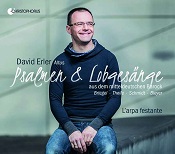 Psalmen & Lobgesänge aus dem mitteldeutschen Barock singt der Altus David Erler, begleitet von L’Arpa Festante, mit Werken von Johann Christoph Schmidt, Georg Bleyer, Johann Theile, Wolfgang Carl Briegel und Johann Christian Starckloff. Mit seiner engelsreinen, leichten und runden Stimme ist Erler ein idealer Interpret für dieses Repertoire, das bis auf eine Komposition von Johann Theile ausschließlich Weltersteinspielungen von Werken enthält, die der Sänger selbst in unterschiedlichen Archiven und Bibliotheken aufgestöbert hat. Mit einem wie dahinschwebend sanften Gesang voller expressiver Wärme bewältigt Erler die schwierigsten Koloraturletten, immer natürlich und feinfühlig, so dass sich am Ende beim Hörer ein Gefühl von Behaglichkeit etabliert hat. In seinen besten Momenten gelingt es Erler, sich langsam bewegende Lieder in ungewöhnliche Gefilde zu führen. – Alto David Erler, accompanied by L’Arpa Festante, performs Psalms & Canticles from the Central German Baroque. The program comprises works by Johann Christoph Schmidt, Georg Bleyer, Johann Theile, Wolfgang Carl Briegel and Johann Christian Starckloff. With his angelic, light and round voice, Erler is an ideal interpreter for this repertoire, which, with the exception of one composition by Johann Theile, contains exclusively world premiere recordings of works that the singer himself tracked down in various archives and libraries. Erler masters the most difficult coloratura chains with a singing that seems to float along, full of expressive warmth, always natural and sensitive, so that by the end the listener has a feeling of comfort. In his best moments, Erler succeeds in taking slow-moving songs into unusual realms. (Christophorus CHR 77453) – ♪♪♪♪♪
Psalmen & Lobgesänge aus dem mitteldeutschen Barock singt der Altus David Erler, begleitet von L’Arpa Festante, mit Werken von Johann Christoph Schmidt, Georg Bleyer, Johann Theile, Wolfgang Carl Briegel und Johann Christian Starckloff. Mit seiner engelsreinen, leichten und runden Stimme ist Erler ein idealer Interpret für dieses Repertoire, das bis auf eine Komposition von Johann Theile ausschließlich Weltersteinspielungen von Werken enthält, die der Sänger selbst in unterschiedlichen Archiven und Bibliotheken aufgestöbert hat. Mit einem wie dahinschwebend sanften Gesang voller expressiver Wärme bewältigt Erler die schwierigsten Koloraturletten, immer natürlich und feinfühlig, so dass sich am Ende beim Hörer ein Gefühl von Behaglichkeit etabliert hat. In seinen besten Momenten gelingt es Erler, sich langsam bewegende Lieder in ungewöhnliche Gefilde zu führen. – Alto David Erler, accompanied by L’Arpa Festante, performs Psalms & Canticles from the Central German Baroque. The program comprises works by Johann Christoph Schmidt, Georg Bleyer, Johann Theile, Wolfgang Carl Briegel and Johann Christian Starckloff. With his angelic, light and round voice, Erler is an ideal interpreter for this repertoire, which, with the exception of one composition by Johann Theile, contains exclusively world premiere recordings of works that the singer himself tracked down in various archives and libraries. Erler masters the most difficult coloratura chains with a singing that seems to float along, full of expressive warmth, always natural and sensitive, so that by the end the listener has a feeling of comfort. In his best moments, Erler succeeds in taking slow-moving songs into unusual realms. (Christophorus CHR 77453) – ♪♪♪♪♪
Goreckis Flötenwerke
Die Flötistin Ewa Liebchen hat zusammen mit einigen Kollegen Flötenwerke von Henryk Gorecki aufgenommen. Das Programm beginnt keck mit Valentine Piece und wird mit For You und Good Night zunehmend kontemplativer und elegischer. Die technisch beeindruckende Künstlerin hat das bewusst so aufgebaut, um das Album zu einer Art Abschiedsritual für den Komponisten werden zu lassen. Leider liegt der CD kein Booklet bei, das Informationen über Werke und ausübende Musiker geben würde, was ein seriöses Manko ist und das Produkt quasi nur für Kenner der Materie empfehlenswert macht. – Together with some colleagues, flutist Ewa Liebchen has recorded flute works by Henryk Gorecki. The program begins perky with Valentine Piece and becomes increasingly contemplative and elegiac with For You and Good Night. The technically impressive artist deliberately structured the program this way to make the album a kind of farewell ritual for the composer. Unfortunately, the CD does not come with a booklet that would give information about works and performing musicians, which is a serious shortcoming and makes the product quasi recommendable only for connoisseurs of the matter. (Dux 1705) – ♪♪♪♪
Alle Lieder von Peter Heise
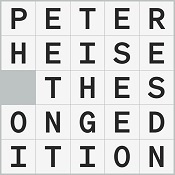 Der dänische Komponist Peter Heise 1830-1879 hat um die 300 Lieder komponiert, die meisten auf dänische Texte, einige wenige auch auf deutsche Gedichte. Dacapo präsentiert nun zum ersten Mal eine Ausgabe, die diese Lieder auf 11 CDs vorstellt. Freunde des Liedgesangs werden diese romantischen und melodisch feinen Lieder in durchwegs guten Interpretationen zu schätzen wissen. Den Produzenten muss es hoch angerechnet werden, dass sie mit einer Vielzahl von männlichen und weiblichen Stimmen immer den passenden Stimmtyp für die Lieder gefunden haben. – The Danish composer Peter Heise 1830-1879 composed about 300 songs, most of them on Danish texts, a few also on German poems. Dacapo now presents the complete recording of those songs. Anyone loving lieder will appreciate these romantic and melodically fine songs in consistently good interpretations. The producers must be given credit for always finding the right voice type for the songs with a variety of male and female voices. (Dacapo 8.201101) – ♪♪♪♪
Der dänische Komponist Peter Heise 1830-1879 hat um die 300 Lieder komponiert, die meisten auf dänische Texte, einige wenige auch auf deutsche Gedichte. Dacapo präsentiert nun zum ersten Mal eine Ausgabe, die diese Lieder auf 11 CDs vorstellt. Freunde des Liedgesangs werden diese romantischen und melodisch feinen Lieder in durchwegs guten Interpretationen zu schätzen wissen. Den Produzenten muss es hoch angerechnet werden, dass sie mit einer Vielzahl von männlichen und weiblichen Stimmen immer den passenden Stimmtyp für die Lieder gefunden haben. – The Danish composer Peter Heise 1830-1879 composed about 300 songs, most of them on Danish texts, a few also on German poems. Dacapo now presents the complete recording of those songs. Anyone loving lieder will appreciate these romantic and melodically fine songs in consistently good interpretations. The producers must be given credit for always finding the right voice type for the songs with a variety of male and female voices. (Dacapo 8.201101) – ♪♪♪♪




